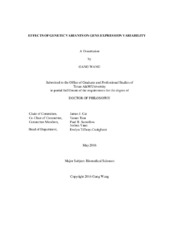| dc.description.abstract | Variation and variability of gene expression are central concepts in biology. Variation refers to differences among individuals, whereas variability refers to the potential of a population to vary. The advent of next-generation sequencing technology has led to the accumulation of an ever-increasing number of population level, largescale genotype and gene expression data sets, which provide excellent opportunities to identify the genetic loci that potentially affect gene expression variation and variability.
Over the last several years, much effort has been made to identify genetic loci that affect the mean differences in phenotypic expression between genotypes, but these studies have largely ignored loci that affect the variance of phenotypic expression within individual genotypes. Although studies of expression quantitative trait loci (eQTL) have established a convincing relationship between genotype and levels of gene expression, the impact of genetic variants on gene expression variance remains unclear. In addition, the analytical frameworks adopted by most eQTL studies have been based on population-level test statistics, which are powerful for assessing the effects of common genetic variants, but not rare or private genetic variants. Few frameworks or statistics are available for assessing the impacts of rare genetic mutations on gene expression. Thus, a new statistical method is required to address this issue.
In this dissertation, I aim to address these questions in humans using publically available large-scale, Next-generation RNA sequencing datasets and new experimental data from my own work. I first adopted a new statistical method called double generalized linear model (DGLM) to study the effect of common genetic variants on gene expression variability, which I define as expression variability QTL (evQTL), using data from the TwinsUK study. I searched the whole genome to identify common genetic variants associated with variable expression at cis-acting genes and showed the contribution of both genetic and nongenetic factors to variable gene expression. I next examined two distinct modes of action of evQTLs: GxG interaction (the interaction between genotypes at different loci) and GxE interaction (the interaction between genotype and environment), which showed that common genetic variants work interactively or independently to influence gene expression variance. Lastly, I established a novel analytical framework to evaluate the effects of rare or private variants on gene expression variability. This method starts from the identification of outlier individuals that show markedly different gene expression from the majority of a population, and then reveals the contributions of private SNPs to the aberrant gene expression in these outliers. | en |


